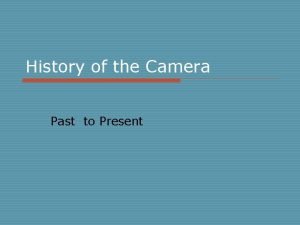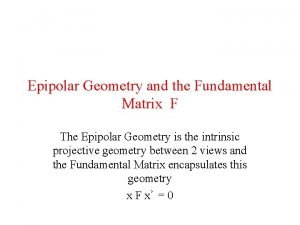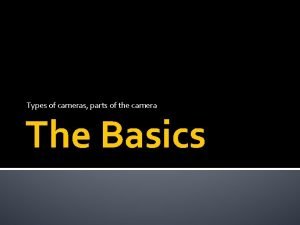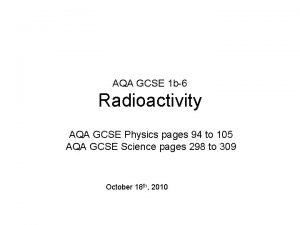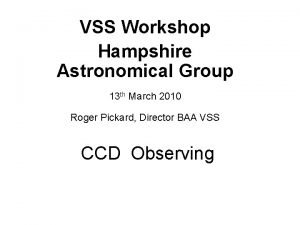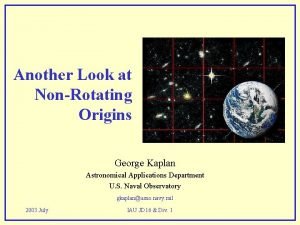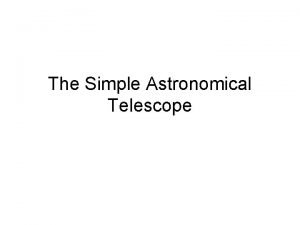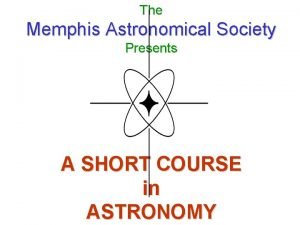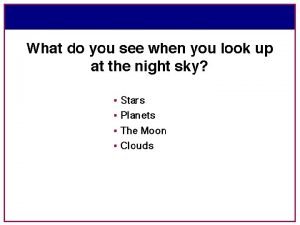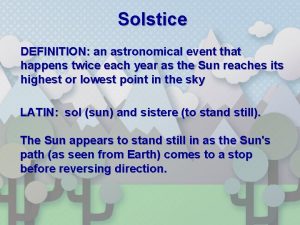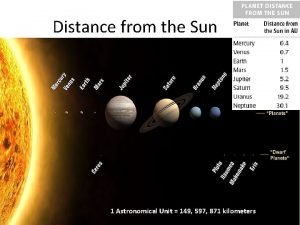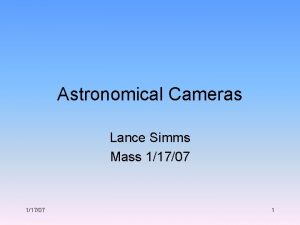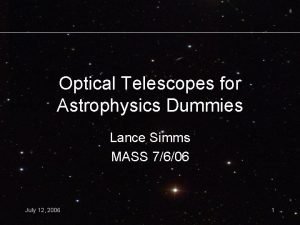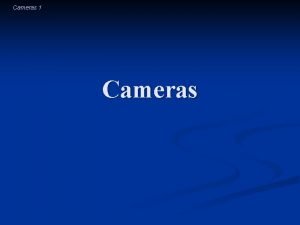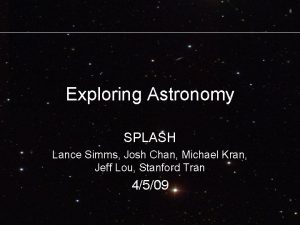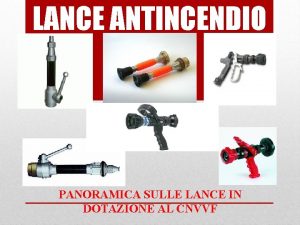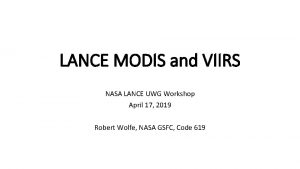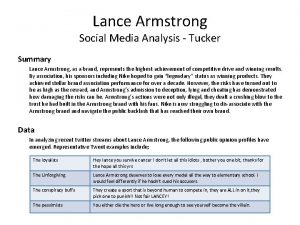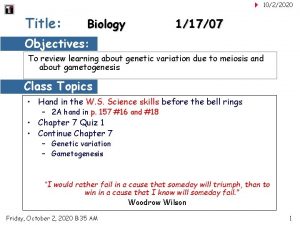Astronomical Cameras Lance Simms Mass 11707 1 The





















- Slides: 21

Astronomical Cameras Lance Simms Mass 1/17/07 1

The Old Days That star looks like a magnitude 2. 3 You’s trippin! No way it’s brighter than 2. 5! My head’s bigger. You know I’m right. 1/17/07 2

Subjective Ancient Photometry The measurement of apparent magnitudes of astronomical objects, performed through various filters, i. e. different wavelength bands. Hipparchus (64 bc-24 ad) • Divided stars into six magnitudes. 1 -brightest …… 6 -dimmest • He did it by eye!! 1/17/07 3

Observations with the Naked Eye • Maximum sensitivity at 560 nm • Cones give color vision • Rods give low intensity light vision: ~5 -9 photons within 100 milliseconds to signal brain • Most people sensitive to 400 -700 • Others are sensitive to 380 -780 • What about Hipparchus? Limits with a dark adapted eye: With Naked eye: With 20 cm telescope: 1/17/07 6 th Magnitude 20 th Magnitude 4

The First Astrophotograph • Taken by John William Draper in 1840 • It was a daguerreotype of the Moon Positive-image picture made by: 1) Exposing 2) Developing by placing cup of heated mercury underneath exposed image 3) “Fixing” image by dipping it in solution of hyposuphite of soda � 1/17/07 silver halide silver 5

The First Astronomical Cameras • Cameras used by Warren De La Rue to photograph the moon in early 1850 s • Used Wet Collodion plates (equivalent of film) 1/17/07 Photos taken from http: //www. mhs. ox. ac. uk/cameras/index. htm? overview 6

Wet Collodion Pictures…Messy Improvement • Used on large telescopes from 1850 -1890 or so � • Involves solutions of iodides and bromides smeared onto a glass plate, dipped into a solution of silver nitrate. • Plate is wet and dripping while picture is taken. • Must be developed within 10 minutes or image is ruined. Horse-drawn darkrooms!! Room for Improvement with Wet Collodions - Long exposure times for little reward - Very weak response to red light - Do away with horse manure 1/17/07 7

Improvements in Emulsion Photography 1871 British Chemist Richard Leach Maddox uses gelatin in place of collodion for less sensitive “dry plate”. Stellar photography is practical. 1880 Improvements in dry plates make them 60 times more sensitive than wet plates 1910 s Eastman-Kodak company works with astronomical observatories to increase sensitivity and refine granularity 1978 -80 David Malin invents new techniques for imaging faint objects in color using RGB filters Emulsion 1/17/07 Photograph made using dry gelatin emulsion A mixture of two immiscible substances like Silver halide and gelatin. Other examples include espresso and mayonnaise. 8

Pretty Emulsion Pictures 100’ Horsehead Nebula in Orion. Images on 3 different emulsions. Exposure times of 60 m 60 m. 1/17/07 2. 5’ Shapley 1 planetary nebula. Images on 3 different emulsions. Exposure times of 35 m 30 m 9

Wet or Dry: Better than the Naked Eye • Human eye cannot “integrate” photons like emulsion does. • Image can be used to do objective photometry. Sending light through negative and measuring how much gets through. Emulsion Photometry Fout Fin Very Nonlinear! Fin Fout d. Et- Flux in (shine a light) Flux out (measure with diode) density of silver atoms exposure value exposure time 1/17/07 d(x, y) 10

Enter the CCD! Charge Coupled Devices - Invented in 1969 by William Boyd and George Smith at Bell Laborotories in New Jersey. - No plates or film or wet pastes; just good ol’ fashion circuits - Superior to emulsion photographs in almost every regard Photos: Top: A plethora of CCDs Bottom: Kodak KAI-1301 E 1024 x 1280 (1. 3 Mpixels) array with 4 micron pixels. 1/17/07 11

The Overall Structure • CCD consists of a set of picture elements (pixels) • Main material is a semiconductor like Silicon or Germanium • To “read” an image, the charge is coupled from one pixel to another • Typical size of a pixel is about 10 microns on a side • It has been likened to collecting rain in buckets and putting them on a conveyor belt to be fed out. 1/17/07 Photo taken from Electronic and Computer-Aided Astronomy: from Eyes to Electronic Sensors 12

A Cross Section Region Name Material Field-Free Region P-type material Depletion Region P-type material Buried channel N-type material Insulating Region Silicon Dioxide Metal Gate 1/17/07 A Single Pixel VB VG 13

Collecting Charge in an Exposure 1) Photon Comes in and enters material 2) It knocks an electron into the conduction band so it can move through the material A Single Pixel hole e- VB 3) Electrons Collect in a potential well. # Electrons is proportional to light that’s hit the pixel. VG 1/17/07 14

Moving the Charge: Clocking - 3 phase transfer CCD shown above - Each pixel has 3 electrodes that take on three different voltages in sequence. This process is called “clocking” 1/17/07 Photo taken from Electronic and Computer-Aided Astronomy: from Eyes to Electronic Sensors 15

More Clocking 1 1 of 3 electrodes on a pixel is high 1 Adjacent electrode is brought high. Lets charge leak over. 2 2 3 Adjacent electrode stays high while other goes low. 3 2 Sets of Clocks: 1 set for horizontal shifting (fast) 1 set for vertical shifting (slow) Transfer in perpendicualr direction blocked by channel stops 1/17/07 16

Readout Slow Clock Fast Clock Output amplfier gives analog voltage. Digitizing that gives Analog Data Unit (ADU) 1/17/07 17

Keeping It Cold CCDs are subject to dark currentcharges liberated by thermal motion rather than light. The colder they are , the less dark current there is. For amateurs, a peltier module with cooling fins works well (top) Research cameras are generally put into Dewars and cooled with liquid nitrogen (bottom). 1/17/07 18

Sensitivity -- Quantum Efficiency - CCDs are much more sensitive to light than emulsions or the eye - No threshold for number of photons per unit time to liberate a charge as in emulsions. Quantum Efficiency A measure of how many photons incident on the detector are converted to charge (0 -100%) at a given wavelength. 1/17/07 19

Photometry Couldn’t be much easier • A little ambiguity about where you count, but digital numbers are easy to add • Also have to worry about noise in the readout amplifier and non-uniform response in pixels of the CCD. Much time is spent calibrating the device to deal with this. 1/17/07 20

Nowadays … we’re closer to That star measures 1100 counts in the detector. That means it’s magnitude 2. 3 1/17/07 You’re absolutely right! You still got a big ass head. 21
 Lance simms
Lance simms Lance simms
Lance simms Lauren simms
Lauren simms Sffas 50
Sffas 50 How does stem and leaf plot work
How does stem and leaf plot work Camera past tense
Camera past tense Image formation in camera
Image formation in camera Speed detection of moving vehicle using speed cameras ppt
Speed detection of moving vehicle using speed cameras ppt Canonical cameras
Canonical cameras Parts of cameras
Parts of cameras Gamma cameras bbc bitesize
Gamma cameras bbc bitesize Hampshire astronomical group
Hampshire astronomical group Astronomical applications department
Astronomical applications department Telescope magnification formula
Telescope magnification formula Astronomical clock lyon france
Astronomical clock lyon france Star testing astronomical telescopes
Star testing astronomical telescopes Memphis astronomical society
Memphis astronomical society Astronomical coordinates
Astronomical coordinates International association of astronomical artists
International association of astronomical artists Solstice definition simple
Solstice definition simple Seasons diagram
Seasons diagram Guildford astronomical society
Guildford astronomical society





